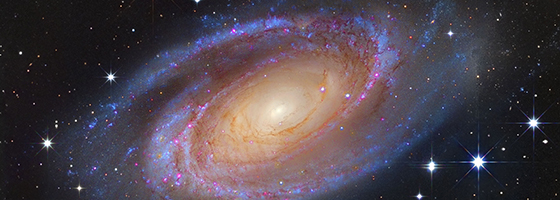Our representation of the Universe and its history is described by the equations of Einstein's general relativity, Newton's universal gravitation, and quantum mechanics. The unanimous model to date is that of a Big Bang followed by an expansion. "In this model, there is a starting hypothesis that I do not think was taken into account," says André Maeder, Honorary Professor in the Department of Astronomy at the UNIGE Faculty of Science, "It's that of the scale invariance of vacuum, or in other words, that the vacuum and its properties do not change following expansion or contraction, "he says. Now, emptiness plays a primordial role in Einstein's equations by intervening in a quantity called cosmological constant and on which depends the resulting Universe model. Based on this hypothesis, André Maeder therefore reconsiders today the model of the Universe and recalls that the scale invariance of the vacuum is also present in the fundamental theory of electromagnetism.
After having passed to his new model the cosmological tests and found that it corresponds to the observations, it discovers that this one predicts the acceleration of the expansion of the Universe without any particle or black energy being necessary for explain the acceleration. In other words, the dark energy would not exist since the acceleration of the expansion is contained in the equations of physics.
In a second time, he is interested in Newton's law, a special case of the equations of general relativity. This one is also slightly modified when the model integrates the new hypothesis of André Maeder. Indeed, it contains a very small term of outward acceleration, particularly significant at low densities. This modified law, applied to clusters of galaxies, leads to cluster masses in agreement with that of visible matter (contrary to what Zwicky said in 1933), which means that no dark matter is needed to explain high speeds of galaxies in clusters. A second test shows that this law also predicts high velocities for stars in the outer regions of galaxies (as observed by Vera Rubin), without any dark matter being needed to explain them. Finally, a third test concerns the dispersion of the velocities of the stars oscillating around the plane of the Milky Way. This dispersion, which grows much with the age of the stars considered, is very well explained with the invariant vacuum hypothesis whereas no agreement existed on the origin of this effect.
The discovery of André Maeder paves the way for a new conception of astronomy, capable of raising questions and controversies. "The announcement of this model, which finally solves two great mysteries of astronomy, remains faithful to the spirit of science: nothing is ever acquired, neither in terms of experience or observation, nor on that of the reasoning of the human being", concludes the Geneva astronomer.

